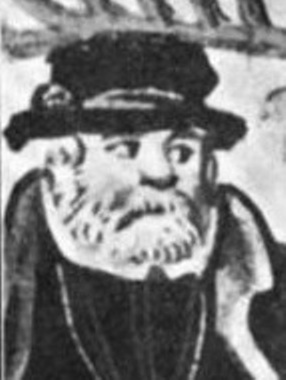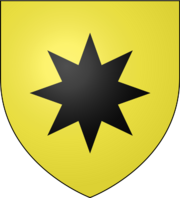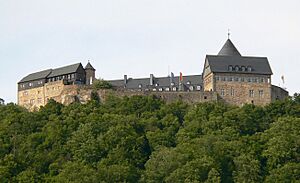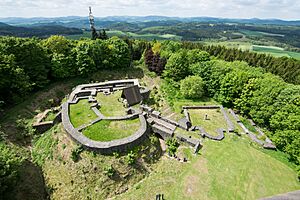Wolrad II, Count of Waldeck-Eisenberg facts for kids
Quick facts for kids
Wolrad II, Count of Waldeck-Eisenberg
|
|
|---|---|

Count Wolrad II of Waldeck-Eisenberg.
|
|
| Count of Waldeck-Eisenberg | |
| Coat of arms |  |
| Reign | 1539–1578 |
| Predecessor | Philip III |
| Successor | Josias I |
| Full name |
Wolrad II Count of Waldeck-Eisenberg
|
| Native name | Wolrad II. Graf von Waldeck-Eisenberg |
| Born | Wolrad Graf von Waldeck-Eisenberg 27 March 1509 |
| Died | 15 April 1578 (aged 69) Eilhausen |
| Buried | 20 April 1578 Saint Kilian Church, Korbach |
| Noble family | House of Waldeck |
| Spouse(s) | Anastasia Günthera of Schwarzburg-Blankenburg |
| Issue Detail |
|
| Father | Philip III of Waldeck-Eisenberg |
| Mother | Adelaide of Hoya |
| Occupation | Canon of St. Gereon's Basilica, Cologne 1520–1544 |
Count Wolrad II 'the Scholar' of Waldeck-Eisenberg (born March 27, 1509 – died April 15, 1578) was a German nobleman. He became the Count of Waldeck-Eisenberg in 1539. Wolrad was known as 'the Scholar' because he was very well educated.
He played a big part in the Reformation in the County of Waldeck. This was a time when many people in Europe changed from the Catholic Church to Protestantism. Wolrad and his family stood up to the Holy Roman Emperor. They fought for their right to be Protestant and made sure their county followed the new faith. Wolrad was a key leader in this religious change.
Contents
Life and Education
Wolrad was born on March 27, 1509. He was the second son of Count Philip III of Waldeck-Eisenberg and his first wife, Countess Adelaide of Hoya.
His father sent him to the royal court in Kassel. There, he studied alongside the young Landgrave Philip I of Hesse. Wolrad also studied in Bielefeld and at the court of the Prince-bishop in Liège. He traveled through France and learned to speak French perfectly. He also mastered Latin and Greek. His wide knowledge later earned him the nickname 'the Scholar'.
Becoming a Count
Wolrad first worked as a clergyman. From 1520, he was a canon at St. Gereon's Basilica in Cologne. In 1544, he gave up this position to his half-brother, Philip V.
His father, who was ill, called Wolrad back to Waldeck in 1536. He needed help managing the county. On November 22, 1538, the County of Waldeck was divided by a treaty. This was done with the help of Landgrave Philip I of Hesse.
Wolrad and his brother Otto V received one part of the county. This included half of Waldeck Castle and half of the city of Waldeck. They also received Eisenberg Castle and other villages. After his father died in 1539, Wolrad took control. His brother Otto gave up his share and joined a religious order. Wolrad made Eisenberg Castle his main home. He and his son Josias later made the castle even bigger.
The Reformation in Waldeck
By 1529, the Protestant faith was common in most of Waldeck. However, some churches and important citizens, especially in Korbach, remained Catholic. The Counts of Waldeck found it hard to change these religious differences.
In May 1543, they brought in the Protestant Reformer Adam Krafft. He helped complete the Reformation in the County of Waldeck. This meant that most of the county became Protestant.
Facing the Emperor
Because of his excellent education, Landgrave Philip I took Count Wolrad II to a religious meeting in 1546. This meeting was called the Regensburger Religionsgespräch. Emperor Charles V used it to distract people from his plans to go to war against the Reformation.
Meanwhile, the Schmalkaldic League was getting ready for war. This League was formed in 1531 by Protestant regions and cities. Its leaders were Elector John Frederick I of Saxony and Landgrave Philip I. In mid-1546, they formed an army. The Counts of Waldeck helped them.
The Emperor won the Schmalkaldic War on April 24, 1547, at the Battle of Mühlberg. The Counts of Waldeck had to sign a peace treaty with the Emperor. The Emperor did not see them as subjects of Hesse. He saw them as Imperial Counts, meaning they answered directly to him.
So, he ordered them to come to the Diet of Augsburg in 1548. They had to explain why they joined the Schmalkaldic League's army. This event showed that Waldeck was directly under the Emperor, not under Hesse.
Wolrad's Pardon
Wolrad traveled to Augsburg with his half-brothers Philip V and John I. He arrived on April 14, 1548. It took weeks for the Counts of Waldeck to find people to speak for them.
At the end of May, the Emperor said an apology was not enough. Philip and John had to pay 5,000 guilders. Wolrad had to pay 8,000 guilders. The Emperor said Wolrad had spoken and acted against him more than the others. They also had to give up large amounts of money they were owed.
Wolrad struggled to get the money. He had to pledge his property and borrow from relatives and his people. He also had to pay over 2,000 guilders for his travel and stay in Augsburg. He even pledged his share of Waldeck Castle.
The Emperor was especially upset about Wolrad's part in the Regensburger Religionsgespräch. Wolrad had to wait a long time and ask for help to be allowed to see the Emperor. Finally, Charles granted him mercy. On June 22, 1548, the Emperor signed the pardon document. The next day, after more than two months, Wolrad and Philip could go home. The counts did not give up Protestantism.
Religious Freedom and Independence
At the Imperial Diet, the Emperor issued the Interim. This was a law meant to bridge the time until a church council could unite Protestants and Catholics. But it made Protestants subject to Catholic bishops and the Pope again.
There was strong resistance to this law. Wolrad met with his ministers on August 14, 1548. He asked for their opinions and told them not to leave the Protestant faith. He promised to support them. Only a few people followed the Interim. The Emperor removed it in 1552.
Hesse became weaker after its leader, Landgrave Philip I, was imprisoned for five years. Also, the Schmalkaldic War left Hesse with many debts. Because of this, the Waldeck region started to move away from Hesse.
On June 22, 1549, a court in Speyer decided that Hesse could not free Waldeck from its duties to the Emperor. The Counts of Waldeck, as direct subjects of the Emperor, had to pay imperial taxes themselves. Collecting these taxes was hard. This led to better management of the county.
After the Imperial and Religion Peace of Augsburg in 1555, the Counts of Waldeck wanted more independence. This peace agreement allowed each local ruler to choose the religion for their area. In 1556, Counts Wolrad II, Philip IV, John I, and Samuel issued a church order. They slowly took over the monasteries from the church.
Later Life and Death
Wolrad moved his court to Eilhausen on August 15, 1577. This was a few months before he died. His son Josias took over Eisenberg Castle.
Wolrad died in Eilhausen on April 15, 1578. He was buried in Saint Kilian Church in Korbach on April 20. His oldest living son, Josias, became the new Count of Waldeck-Eisenberg.
Marriage and Children
Wolrad married Countess Anastasia Günthera of Schwarzburg-Blankenburg on June 6, 1546, at Waldeck Castle. Anastasia was born on March 31, 1528, in Arnstadt. She died on April 1, 1570, at Eisenberg Castle. She was buried on April 5, 1570, in the Saint Kilian Church in Korbach.
Wolrad and Anastasia had many children:
- Catherine (born September 20, 1547 – died June 16, 1613). She became the Abbess of Schaaken Abbey in 1588.
- Francis (born April 8, 1549 – died March 7, 1552).
- Elizabeth (born June 27/28, 1550 – died March 6, 1552).
- Anne Erica (born September 17, 1551 – died October 15, 1611). She became the Abbess of Gandersheim Abbey in 1589.
- Henry William (born November 3, 1552 – died December 28, 1559).
- Count Josias I (born March 18, 1554 – died August 6, 1588). He became Count of Waldeck-Eisenberg after his father in 1578. He married Countess Mary of Barby and Mühlingen in 1582.
- Adelaide Walpurga (born September 11, 1555 – died June 17, 1570).
- Amelia (born February 28, 1558 – died March 18, 1562).
- John Günther (born July 13, 1559 – died November 19, 1559).
- Jutta (born November 12, 1560 – died 1620). She married Lord Henry XVIII of Reuss-Obergreiz in 1583.
- Magdalene Lucy (born February 16, 1562 – died April 1, 1621).
- Count Wolrad III (born June 16, 1563 – died November 12, 1587). He served in the army of Count Palatine John Casimir.
- Catherine Anastasia (born March 20, 1566 – died February 8, 1635). She married Count Wolfgang of Löwenstein-Scharfeneck in 1585.
Images for kids




